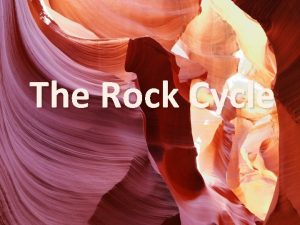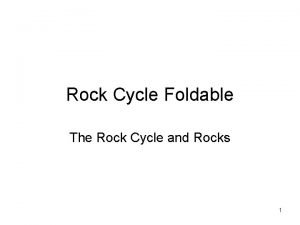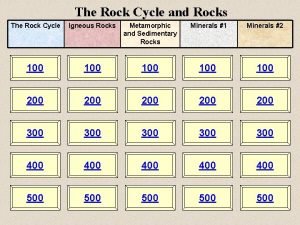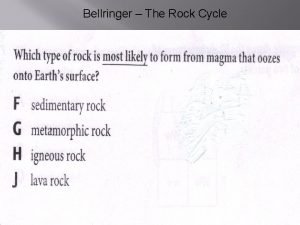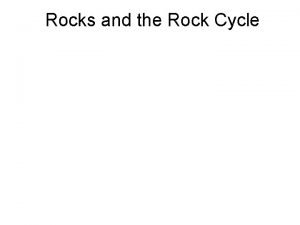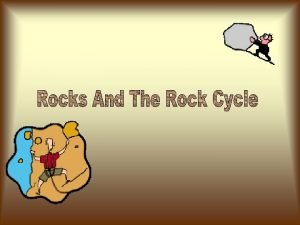The Rock Cycle Rock Cycle A rock is












- Slides: 12

The Rock Cycle

Rock Cycle: § A rock is a mixture of minerals, mineraloids, glass or organic matter. § The rocky cycle shows how one rock changes into another. § Rocks are changed by the following: § Weathering § Compaction § Melting Erosion Cementation Cooling

Rock Cycle

Igneous Rocks § Igneous rock- Occurs when molten material from a volcano or from deep inside Earth cools. Most abundant type of rock on Earth. obsidian pumice

Igneous Rocks cont. § Great pressure and heat melt the rock to form magma § Also radioactive elements in rock generate thermal energy § Heats rocks § Less dense than surrounding rocks, forced upward and released from volcanoes as lava. § Lava and magma contain Silica § The more silica the more viscous (thick) it is.

Metamorphic Rocks § Metamorphic Rock- Rocks that have changed due to temperature and pressure increases or that undergo changes in composition § Metamorphic Rock § Formed from igneous, sedimentary or other metamorphic rock § Changes in appearance, texture, crystal, structure, and or mineral content

Metamorphic Rocks cont. § Heat and pressure not enough to melt the rock like igneous § Pressure and heat flatten rocks, exchanges atoms with other minerals § Amount of pressure can determine what rock will form § One rock can change into several different rocks § i. e. shale will change to slate but as more pressure is applied could change into phyllite, schist, and gneiss

Metamorphic Rocks quartzite hornfels marble

Sedimentary Rock § Sedimentary Rock- Formed when sediments become pressed or cemented together or when sediments precipitate out of solution § Sedimentary Rock § 75% of Earth’s Surface § Formed from sediments § Sediments- loose materials such as rock fragments, mineral grains, and bits of plant and animal remains that have undergone weathering and erosion § Minerals dissolved in water are also sediments § Come from already existing rocks that are weathered and eroded

Sedimentary Rocks Cont. § Movement of weathered material is called erosion. § Often form layers § Oldest layers are at the bottom § Except when disturbed by some force within the Earth § Compaction § Large sediments cannot be compacted alone by pressure § Cementation occurs when these large sediments are glued together by minerals deposited b/w the sediments by water

Sedimentary rocks conglomerate coquina Limestone breccia

Uses of Rock § Construction § Brick, Facing, Monuments § Slate § Pool tables, Roofs § Crushed § Roads, Erosion control, concrete
 Igneous rock to metamorphic rock
Igneous rock to metamorphic rock Hát kết hợp bộ gõ cơ thể
Hát kết hợp bộ gõ cơ thể Frameset trong html5
Frameset trong html5 Bổ thể
Bổ thể Tỉ lệ cơ thể trẻ em
Tỉ lệ cơ thể trẻ em Voi kéo gỗ như thế nào
Voi kéo gỗ như thế nào Thang điểm glasgow
Thang điểm glasgow Chúa yêu trần thế
Chúa yêu trần thế Môn thể thao bắt đầu bằng từ chạy
Môn thể thao bắt đầu bằng từ chạy Thế nào là hệ số cao nhất
Thế nào là hệ số cao nhất Các châu lục và đại dương trên thế giới
Các châu lục và đại dương trên thế giới Công thức tiính động năng
Công thức tiính động năng Trời xanh đây là của chúng ta thể thơ
Trời xanh đây là của chúng ta thể thơ













